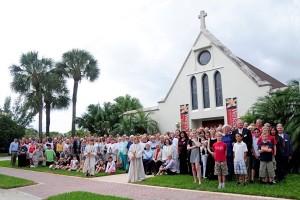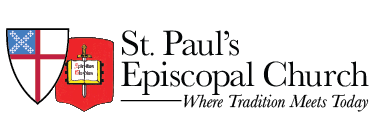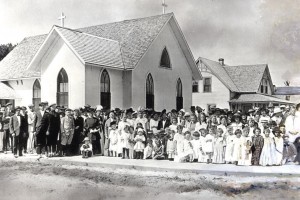 In 1898 Sunday School classes for local Episcopal children were begun in a schoolhouse in what then was called the town of Linton. On occasion, Episcopal ministers would come to preach and celebrate Holy Communion.
In 1898 Sunday School classes for local Episcopal children were begun in a schoolhouse in what then was called the town of Linton. On occasion, Episcopal ministers would come to preach and celebrate Holy Communion.
From these earliest informal beginnings, an Episcopal mission was built in 1904 on land where St Paul’s Episcopal Church now stands. In 1919, St Paul’s Episcopal Church became an Organized Mission and made its first report to the Diocese of South Florida. The new mission’s church was leveled by the 1928 hurricane that ravaged the area, but the congregation persevered and the church was rebuilt in 1929 with $5,000 in United Thank Offering funds contributed by Episcopal Church Women throughout the country.
In May 1946, this Organized Mission was officially recognized as a Parish at the Diocesan Convention in St Petersburg, Florida. The Rev Charles Farrar became its first rector on November 1, 1946. Under his leadership, the church building was enlarged, its beauty was enhanced by new stained glass windows installed as memorials, and the congregation increased from 36 communicants to 275. His successor was the Rev Marland Zimmerman, who came to St Paul’s Episcopal Church in July 1952. During the Rev Zimmerman’s term as rector, a two-story structure was built between the parish house and the church to accommodate the Sunday School. In 1954, the Charter of St Paul’s Episcopal Church was approved and incorporation of the church was accomplished.
The Rev Stiles Lines became rector in May 1961. He was instrumental in the construction in 1963 of St Paul’s Children’s Village and the establishment of St Paul’s Day School for preschoolers. Dr Frederic Bush, Jr began his 10-year service as rector of St Paul’s Episcopal Church on September 1, 1966. Under his guidance, the church continued to flourish, and in 1974, a large rectangular shaped addition was completed, designed with a center courtyard surrounded by church offices, the Guild Room for workshops and meetings, Bush Hall, restrooms, and a spacious Music Room.
Dr Bush retired on December 31, 1976, and one January 1, 1977, the Rev Donald Clawson became rector of St Paul’s Episcopal Church. Under his leadership, the congregation adapted to the new Book of Common Prayer, first proposed at the General Convention of the Episcopal Church in October 1976. It began to be used at St Paul’s Episcopal Church on All Saints’ Sunday, November 5, 1978, with time allowed over the coming weeks for instruction before each service.
Over the next few years, the interior of St Paul’s Episcopal Church was remodeled and a new Moeller pipe organ containing 3,000 pipes was installed. In March 1989, the Episcopal Church Women opened their Turnover Shop, a thrift shop in downtown Delray Beach, which closed in 2013.
St Paul’s Episcopal Church tradition of community outreach has been reflected in the 1990s in parishioners’ assistance to the victims of Hurricane Andrew in southern Dade County, sponsorship of a Habitat for Humanity house in Delray Beach, monthly preparation of food for the needy by the Episcopal Churchmen, the ‘Music at St. Paul’s’ concert series, and many other projects.
A Columbarium – a structure with niches for the ashes of the deceased – was completed in May 1994 in the Memorial Garden facing Swinton Avenue between the church and the parish hall. The Columbarium underwent an extensive redesign and replanting project which was completed in the Summer of 2008. In 1997, an Audio Link Personal Listening System, funded by the ECW, was installed in the church to provide enhanced hearing for those who needed it during worship services.
The Rev Clawson preached for the last time as rector of St Paul’s Episcopal Church on February 1, 1998. He had served in this capacity for 21 years, a record for the parish, and had decided to retire. The Rev Duane Alvord served as interim rector for one year.
The Rev William H (“Chip”) Stokes was called to be the sixth rector of St Paul’s Episcopal Church and started on January 1, 1999. During his tenure, St Paul’s Episcopal Church has increased its profile in the community. With St Matthew’s Episcopal Church, St Paul’s co-hosted the ‘St Matthew’s – St Paul’s Community Dialogue on Anti-Racism’ in 1999 and 2000. This involved 25 leaders of the community in an on-going dialogue about how to identify and fight racism. St Paul’s Episcopal Church participates in the annual Martin Luther King Jr. celebration. Paul’s Place, an after-school program for Haitian-American children that live in the immediate community was founded in 2000 by the church. St Paul’s is an active supporter of the Community Food Pantry and the Caring Kitchen Soup Kitchen. Teenagers of the parish have been on pilgrimage to Canterbury Cathedral and other sacred places in England.
St Paul’s Episcopal Church has always played an historic role in Delray Beach. What is now the Delray Beach Playhouse was founded in the church’s parish hall. During World War II, USO dances were also hosted in the church hall. Temple Sinai held services at St Paul’s Episcopal Church before they built their temple. Business and community leaders have often come from the ranks of St Paul’s Episcopal Church.
Not resting on its historical laurels, St Paul’s Episcopal Church launched a new worship service that is radically different from what one usually finds in an Episcopal church. Called “Illuminated Worship,” this informal service takes place in the Parish Hall. A jazz trio led by Larry Mellone offer a wide-range of up-beat eclectic music that includes anything from swing to light rock. Worshipers follow along on brightly illustrated and “illuminated’ screen projections. The designation “illuminated” is an allusion to the “illuminated manuscripts” of the Middle Ages. St. Paul’s Episcopal Church truly is a place “where tradition meets today.”
The Rev. Chip Stokes was elected Bishop of New Jersey in 2013. The Rev. David Knight served as the interim rector until 2015 when we welcomed the Rev. Paul Kane as the current rector of St. Paul’s.

